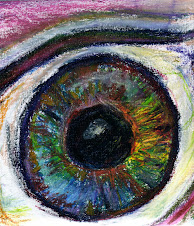Since we read from left to right and from the top of the page down, beginning readers who do not know their left and right may experience some confusion. We call the ability to tell left and right on ourself the visual spatial skill of laterality. Laterality is usually developed, according to Piaget's observations, by the time a child is 7 years old. Projecting that knowledge away from ourself into space is the visual spatial skill of directionality. This involves layers of developmental understanding that evolve in most children by the time they are 11.
Children who have delays in the skills of laterality and directionality mix up their left and right. They often have poor bilateral integration. In other words, they tend not to use both hands or feet efficiently to do tasks like cutting, eating, and alternating their feet going up and down stairs. They probably also have difficulty crossing the midline. By this I mean the physical midline, the ocular midline, and the midline on a page of text or on a worksheet.
So, these children will become frustrated by assignments that involve drawing lines to match information arranged in a column on the left side of the worksheet with additional information arranged in a column on the right side of the worksheet. They may know the correct answer but be unable to connect the lines. They may exhibit poor manuscript handwriting- especially when forming letters and numbers which cross the midline like x, y, M, N, s, v, and w.
Sometimes these children make frequent reversals when reading and writing and the children who are the most developmentally delayed in laterality and directionality may mirror write. They are often labeled dyslexic, a condition that has many competing definitions and involves both visual and auditory perception and processing.
It is possible to build a child's developmental skills of laterality and directionality and to increase their left/right awareness. In fact, occupational therapists and vision therapists spend a lot of time in therapy doing just that for our patients. There are normed tests available to measure a student's development in laterality and directionality that are incorporated in the developmental assessment of a child's visual perceptual skills given by developmental optometrists and by educational psychologists.
I believe that one easy to achieve educational goal should be to provide activities in laterality and directionality for every primary student before they fall behind in reading and writing. This can be done via learning center activities in the classroom. To that end, the second book, the "Yellow Book", in the Eye Can Too! Read series, published by Home School Incorporated, (available in the next few weeks on their website) provides an assortment of activities that home-school families and classroom teachers can use. There are clear directions followed by questions to inform your observation of your student as they do the activities.
This blog is intended to give information for parents and teachers about learning-related visual skills. I encourage each reader to become a follower of this blog and also to become a fan of the Eye Can Too! Read FaceBook page. Please use the wall on the FaceBook page to ask your questions about vision and learning. That will help me to select topics for this blog. Thanks.
Thursday, December 18, 2008
Why Is Left/Right Awareness Important to Reading?
Subscribe to:
Post Comments (Atom)





No comments:
Post a Comment